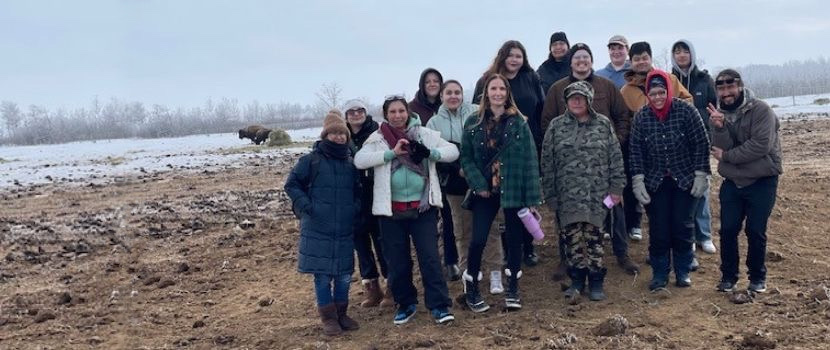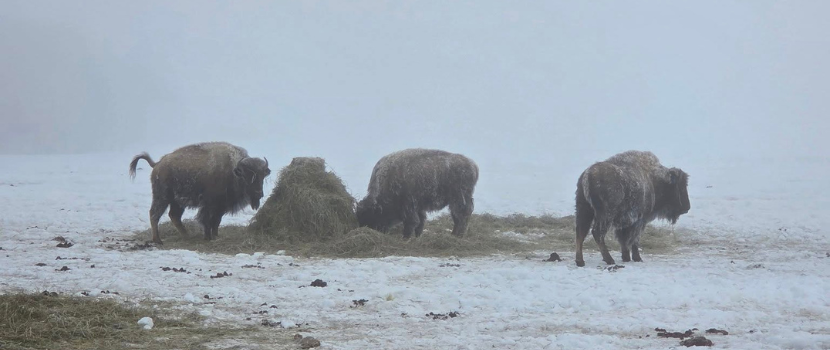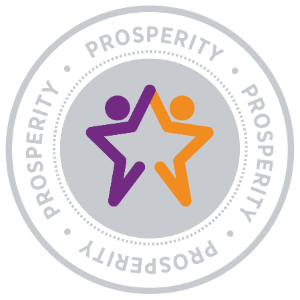
Guided by Indigenous Knowledge Keepers, students from Saskatchewan Polytechnic and Regina Public Schools recently participated in a buffalo harvest at Peepeekisis Cree Nation. This hands-on experience involved a pipe ceremony, breaking down the buffalo, harvesting the meat and removing the hide. It was an opportunity to be part of the cultural and spiritual practices of a buffalo harvest and apply traditional teachings to everyday life.
Sixteen Sask Polytech students took part, including the first-year culinary arts class, Indigenous Students’ Centre participants and students from the Wîcihitowin Transition Program. Organized by the wītōkamāhtōtān Indigenous Student Success team, this was the first time Sask Polytech students participated in a buffalo harvest.
In the days leading up to the harvest, a pipe ceremony was held. Led by Elder Gary Gott, the ceremony allowed participants to connect spiritually with the buffalo and set respectful intentions for the harvest. “Through prayer at the ceremony we ask that things go right, that this animal that’s going to give us life doesn’t needlessly suffer,” says Elder Gary.
The buffalo is deeply significant and has been an integral part of Indigenous culture for generations. “Indigenous people followed the buffalo. That was how we sustained ourselves,” says Brandi Kohl, Indigenous Students’ Centre coordinator at Regina campus and event organizer. The harvest represents not just a source of food, but a connection to the land, the community and the traditions passed down through generations. “It’s a connection to something our ancestors have done for generations,” adds Elder Gary.
In the pastures at Peepeekisis Cree Nation, over 100 buffalo scattered the plains as the Knowledge Keeper and heard caretaker began the harvest. Elder Gary recalls, “The buffalo heard our prayers and selected itself, stepping away from the herd.”

Students were captivated by the process of breaking down the buffalo. They learned about the use of organs in food, medicine and ritual, as well as the importance of sustainable use of all animal parts. “Every part of the buffalo is used, symbolizing respect and gratitude for the animal's life. From the horns and bones to the hide and meat, it’s all used for things like clothing, water bottles, tools and food,” Kohl notes.
The respect shown in techniques used was particularly striking to participants. Learning about the significance of the buffalo and the depth of meaning for every part of the animal stood out for many of them.
Knowledge Keepers explained how hides are used for traditional clothing, shelter and ceremonial purposes. “The Elders and Knowledge Keepers taught us step-by-step what to do. I cherish and appreciate the wisdom they shared. It was an amazing experience,” says Traci Severight, Sask Polytech Adult Basic Education student.

The buffalo harvest tied directly into the curriculum of the Culinary Arts program, as instructor Marcie Faucher explains, "This semester, we're learning about meat processing, including composition and structure of meat, major and primal cuts, and organs. The buffalo harvest allowed students to see these aspects firsthand." Students also learned about the many uses of meat, bone and sinew.
Faucher also adds, “At the harvest, students were able to see several buffalo parts that aren’t easily purchased, and bring back the front quarter of the buffalo, as well as the heart and tongue, for use in class.” Students have made stock, flat iron steaks and pepperoni sausage. In an upcoming course, they will also be using the buffalo tongue to prepare Tacos de Lengua, a traditional Mexican dish.
The remaining buffalo meat was processed by the Peepeekisis school land-based learning program, shared among participants and used at the Indigenous Community Kitchen, a monthly series for Indigenous students at Regina campus. The Community Kitchen, funded by the South Saskatchewan Community Foundation Truth and Reconciliation Fund, helps build community and equips Indigenous students who may be facing food insecurity with resources and knowledge to support themselves and their families. A primary focus of the Community Kitchen is Indigenous food sovereignty which recognizes the importance of communities feeding themselves with traditional foods and maintaining relationships with land and community. Topics include healthy and affordable meal preparation, accessing community resources and traditional hunting and harvesting techniques.
Kohl looks forward to gathering again to cook and share a meal of buffalo steaks with the students. The buffalo harvest is a powerful reminder of the interconnectedness of food, culture and community, leaving participants with a lasting experience.
“Having this hands-on experience inspired me to get more involved in my culture and heritage, to learn how to live off the land like my grandparents did,” says Severight. “This beautiful experience and the connection with the buffalo, it all made me so proud to be Indigenous.”
Learn more about Sask Polytech's wītōkamāhtōtān Indigenous Student Success and Culinary Arts diploma program.
Many full-time programs still have available seats for fall 2025. Find a program and apply today.
Saskatchewan Polytechnic is signatory to the SDG Accord. Sustainable Development Goal alignment is one of the ways Sask Polytech is leading the rise of polytechnic education.



